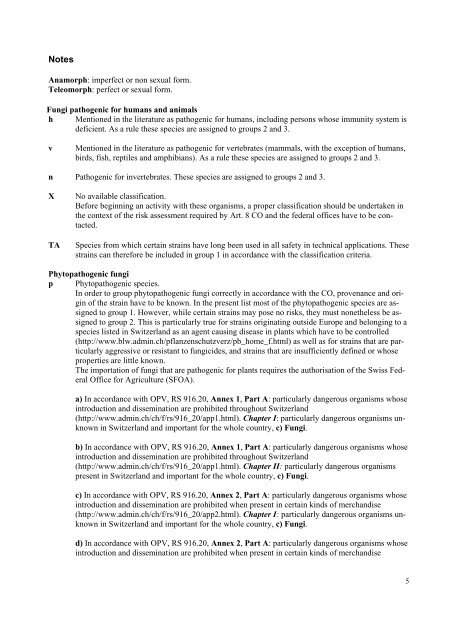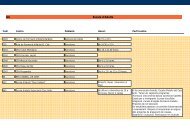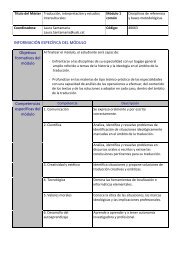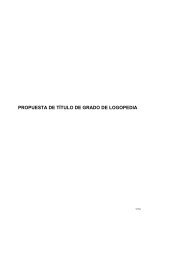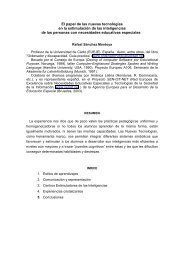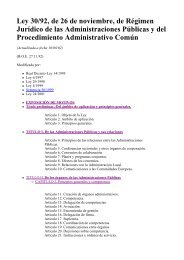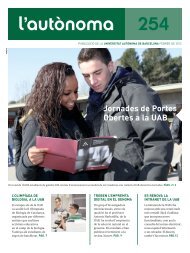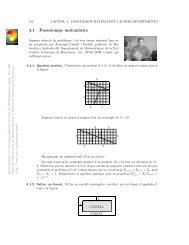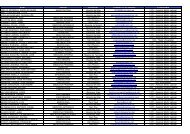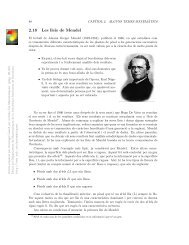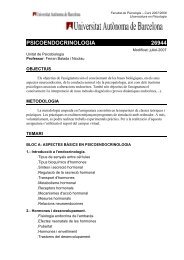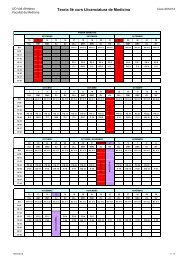GUIDELINES Classification of organisms - Fungi
GUIDELINES Classification of organisms - Fungi
GUIDELINES Classification of organisms - Fungi
Create successful ePaper yourself
Turn your PDF publications into a flip-book with our unique Google optimized e-Paper software.
Notes<br />
Anamorph: imperfect or non sexual form.<br />
Teleomorph: perfect or sexual form.<br />
<strong>Fungi</strong> pathogenic for humans and animals<br />
h Mentioned in the literature as pathogenic for humans, including persons whose immunity system is<br />
deficient. As a rule these species are assigned to groups 2 and 3.<br />
v Mentioned in the literature as pathogenic for vertebrates (mammals, with the exception <strong>of</strong> humans,<br />
birds, fish, reptiles and amphibians). As a rule these species are assigned to groups 2 and 3.<br />
n Pathogenic for invertebrates. These species are assigned to groups 2 and 3.<br />
X No available classification.<br />
Before beginning an activity with these <strong>organisms</strong>, a proper classification should be undertaken in<br />
the context <strong>of</strong> the risk assessment required by Art. 8 CO and the federal <strong>of</strong>fices have to be contacted.<br />
TA Species from which certain strains have long been used in all safety in technical applications. These<br />
strains can therefore be included in group 1 in accordance with the classification criteria.<br />
Phytopathogenic fungi<br />
p Phytopathogenic species.<br />
In order to group phytopathogenic fungi correctly in accordance with the CO, provenance and origin<br />
<strong>of</strong> the strain have to be known. In the present list most <strong>of</strong> the phytopathogenic species are assigned<br />
to group 1. However, while certain strains may pose no risks, they must nonetheless be assigned<br />
to group 2. This is particularly true for strains originating outside Europe and belonging to a<br />
species listed in Switzerland as an agent causing disease in plants which have to be controlled<br />
(http://www.blw.admin.ch/pflanzenschutzverz/pb_home_f.html) as well as for strains that are particularly<br />
aggressive or resistant to fungicides, and strains that are insufficiently defined or whose<br />
properties are little known.<br />
The importation <strong>of</strong> fungi that are pathogenic for plants requires the authorisation <strong>of</strong> the Swiss Federal<br />
Office for Agriculture (SFOA).<br />
a) In accordance with OPV, RS 916.20, Annex 1, Part A: particularly dangerous <strong>organisms</strong> whose<br />
introduction and dissemination are prohibited throughout Switzerland<br />
(http://www.admin.ch/ch/f/rs/916_20/app1.html). Chapter I: particularly dangerous <strong>organisms</strong> unknown<br />
in Switzerland and important for the whole country, c) <strong>Fungi</strong>.<br />
b) In accordance with OPV, RS 916.20, Annex 1, Part A: particularly dangerous <strong>organisms</strong> whose<br />
introduction and dissemination are prohibited throughout Switzerland<br />
(http://www.admin.ch/ch/f/rs/916_20/app1.html). Chapter II: particularly dangerous <strong>organisms</strong><br />
present in Switzerland and important for the whole country, c) <strong>Fungi</strong>.<br />
c) In accordance with OPV, RS 916.20, Annex 2, Part A: particularly dangerous <strong>organisms</strong> whose<br />
introduction and dissemination are prohibited when present in certain kinds <strong>of</strong> merchandise<br />
(http://www.admin.ch/ch/f/rs/916_20/app2.html). Chapter I: particularly dangerous <strong>organisms</strong> unknown<br />
in Switzerland and important for the whole country, c) <strong>Fungi</strong>.<br />
d) In accordance with OPV, RS 916.20, Annex 2, Part A: particularly dangerous <strong>organisms</strong> whose<br />
introduction and dissemination are prohibited when present in certain kinds <strong>of</strong> merchandise<br />
5


